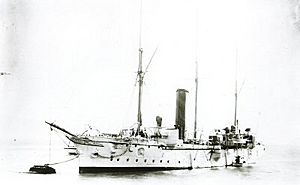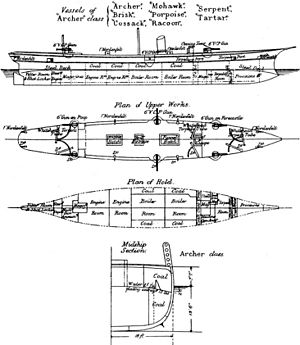HMS Serpent (1887) facts for kids
 |
|
Quick facts for kids History |
|
|---|---|
| Name | HMS Serpent |
| Builder | Devonport Dockyard |
| Laid down | 9 November 1885 |
| Launched | 10 March 1887 |
| Completed | March 1888 |
| Fate | Sunk 10 November 1890 |
| General characteristics | |
| Class and type | Archer-class torpedo cruiser |
| Displacement |
|
| Length | 240 ft (73.15 m) oa |
| Beam | 36 ft (10.97 m) |
| Draught | 14 ft 6 in (4.42 m) |
| Installed power | 4,500 ihp (3,400 kW) |
| Propulsion |
|
| Speed | 17.5 kn (32.4 km/h) |
| Range | 7,000 nmi (13,000 km) |
| Complement | 176 men |
| Armament |
|
| Armour |
|
HMS Serpent, was a special type of warship called an Archer-class in the Royal Navy. She was built at Devonport Dockyard in England. The ship started service in 1888. Sadly, HMS Serpent was lost when she hit rocks off Cape Vilan in northwest Spain. Out of 176 crew members, 173 lost their lives in the accident.
Contents
Building a Torpedo Cruiser
HMS Serpent began being built at Devonport Dockyard on November 9, 1885. She was part of the Archer-class group of ships. The ship was officially launched on March 10, 1887, and was finished in March 1888.
What is a Torpedo Cruiser?
Torpedo cruisers were smaller, fast ships. Their main job was to protect a navy's main fleet from attacks by enemy torpedo boats. They could also use their own torpedoes to attack enemy fleets. The Archer class ships, like Serpent, were bigger versions of earlier torpedo cruisers. They carried more weapons.
Ship's Size and Power
Serpent was about 240-foot (73.15 m) long from end to end. She was 36-foot (10.97 m) wide. The ship weighed about 1,770 long tons (1,800 t) when normal and 1,950 long tons (1,980 t) when fully loaded. Her engines made 4,500 indicated horsepower (3,400 kW) of power. This allowed her to reach a speed of 17.5 knots (32.4 km/h; 20.1 mph). She could travel 7,000 nautical miles (13,000 km; 8,100 mi) without needing to refuel.
Weapons and Protection
HMS Serpent had six large 6-inch guns. She also carried eight smaller 3-pounder guns and two machine guns. For torpedo attacks, she had three 14-inch torpedo tubes. To protect the ship, she had a strong deck that was 3⁄8 inch (10 mm) thick. Her gun shields were 1 inch (25 mm) thick, and the conning tower (where the ship was steered) had 3 inches (76 mm) of armor. A crew of 176 sailors worked on the ship.
Ship's Service and Loss
Serpent took part in naval exercises in 1888 and 1889. During these exercises, her engines sometimes had problems.
The Final Voyage
On November 8, 1890, HMS Serpent left Devonport, England. Her mission was to replace another ship, Acorn, on the West African Station. On the night of November 10, the ship was caught in a very bad storm. This happened in the Bay of Biscay, a bay off the coast of France and Spain.
Tragic Shipwreck
The crew tried to find shelter from the storm. But Serpent ran aground, meaning she hit rocks, off Cape Vilan. This cape is near the village of Camariñas in Galicia, northwest Spain. Almost everyone on board died in the shipwreck. Only three crew members survived. An investigation later found that the ship was lost because of a mistake in navigation.

The sailors who died were buried where their bodies washed ashore. This place is known as the English cemetery, located on the Costa da Morte (Coast of Death) in Galicia. 43°07′19″N 9°11′31″W / 43.122°N 9.192°W
See also
 In Spanish: HMS Serpent (1887) para niños
In Spanish: HMS Serpent (1887) para niños
- HMS Captain: another Royal Navy ship that sank off the Galician coast in 1870


